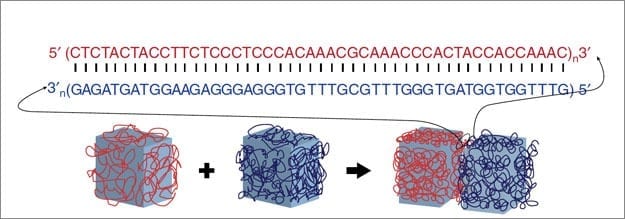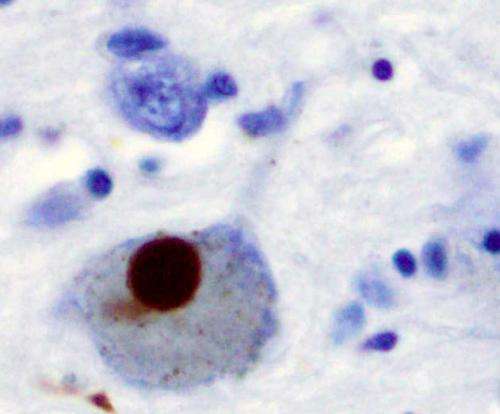
Process enables creation of mechanical components with functionality, such as surgical pins that change color with strain
Tufts University engineers have created a new format of solids made from silk protein that can be preprogrammed with biological, chemical, or optical functions, such as mechanical components that change color with strain, deliver drugs, or respond to light, according to a paper published online this week in Proceedings of the National Academy of Sciences (PNAS).
Using a water-based fabrication method based on protein self-assembly, the researchers generated three-dimensional bulk materials out of silk fibroin, the protein that gives silk its durability. Then they manipulated the bulk materials with water-soluble molecules to create multiple solid forms, from the nano- to the micro-scale, that have embedded, pre-designed functions.
 A silk fibroin screw can be heated to 160 C when exposed to infrared light. Source: Silk Lab.For example, the researchers created a surgical pin that changes color as it nears its mechanical limits and is about to fail, functional screws that can be heated on demand in response to infrared light, and a biocompatible component that enables the sustained release of bioactive agents, such as enzymes.
A silk fibroin screw can be heated to 160 C when exposed to infrared light. Source: Silk Lab.For example, the researchers created a surgical pin that changes color as it nears its mechanical limits and is about to fail, functional screws that can be heated on demand in response to infrared light, and a biocompatible component that enables the sustained release of bioactive agents, such as enzymes.
Although more research is needed, additional applications could include new mechanical components for orthopedics that can be embedded with growth factors or enzymes, a surgical screw that changes color as it reaches its torque limits, hardware such as nuts and bolts that sense and report on the environmental conditions of their surroundings, or household goods that can be remolded or reshaped.
Silk’s unique crystalline structure makes it one of nature’s toughest materials. Fibroin, an insoluble protein found in silk, has a remarkable ability to protect other materials while being fully biocompatible and biodegradable.
“The ability to embed functional elements in biopolymers, control their self-assembly, and modify their ultimate form creates significant opportunities for bio-inspired fabrication of high-performing multifunctional materials,” said senior and corresponding study author Fiorenzo G. Omenetto, Ph.D. Omenetto is the Frank C. Doble Professor in the Department of Biomedical Engineering at Tufts University’s School of Engineering and also has an appointment in the Department of Physics in the School of Arts and Sciences.
Learn more: Engineers create programmable silk-based materials with embedded, pre-designed functions
[osd_subscribe categories=’programmable-materials’ placeholder=’Email Address’ button_text=’Subscribe Now for any new posts on the topic “PROGRAMMABLE MATERIALS”‘]
Receive an email update when we add a new PROGRAMMABLE MATERIALS article.
The Latest on: Programmable materials
[google_news title=”” keyword=”programmable materials” num_posts=”10″ blurb_length=”0″ show_thumb=”left”]
via Google News
The Latest on: Programmable materials
- Formula E program step one on the comeback trail for Lolaon April 27, 2024 at 3:06 pm
More than a decade after disappearing from the motorsport landscape, a sleeping giant is getting ready to awaken. Till Bechtolsheimer gained control of the Lola name, intellectual property, ...
- Bomb-making materials awareness program launches in Austinon April 26, 2024 at 2:57 pm
The City of Austin's Office of Homeland Security and Emergency Management launched a new program to help spread awareness on bomb-making materials.
- Mars And Unreasonable Group Announce First Cohorts For New Programon April 26, 2024 at 1:47 am
The 15 cohorts have been selected as the first wave of the Unreasonable Food program and are headquartered across five continents.
- Library sees slight bump in new patrons since elimination of fines on adult materialson April 25, 2024 at 8:56 am
The Albert Lea Public Library has seen a 7.5% increase in new patrons since eliminating fines on adult materials in September, the library’s director told members of the City Council during a tour ...
- Blue Star Gold Announces 2024 Exploration Program Mobilizationon April 25, 2024 at 5:05 am
Blue Star is listed on the TSX Venture Exchange under the symbol: BAU, the U.S. OTCQB Venture Market under the symbol: BAUFF, and on the Frankfurt Exchange under the symbol: 5WP0. For information on ...
- Environmenton April 25, 2024 at 5:01 am
Recycling will expand across Colorado over the next six years through new curbside programs funded by corporations that create the garbage the state wants to see diverted from landfills.
- Bishop stabbed during Sydney church service backs X's legal case to share video of the attackon April 24, 2024 at 6:03 pm
Five teenagers accused of following a violent extremist ideology have been charged with a range of offenses in an investigation that began with the stabbing of a bishop in a Sydney church, police said ...
- Researchers create first artificial, modifiable cells with programmable DNAon April 24, 2024 at 8:08 am
The achievement holds significant promise for advancements in regenerative medicine, drug delivery methods, and diagnostic technologies.
- Lawmakers greenlight statewide recycling program funded by packaging producerson April 23, 2024 at 1:30 pm
Colorado lawmakers last week approved a program that aims to expand recycling across the entire state and will be funded by large packaging producers.
via Bing News










